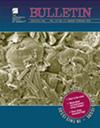Hydrothermal alteration, not metamictization, is the main trigger for modifying zircon in highly evolved granites
IF 3.9
1区 地球科学
Q1 GEOSCIENCES, MULTIDISCIPLINARY
引用次数: 1
Abstract
The question of whether the high U and Th concentrations in zircon are primary or secondary is often difficult to resolve, and a clear understanding of the modification processes of secondary U- and Th-rich zircon is lacking. Zircon crystals from two well-studied, highly evolved granites, the Jiangjunshan muscovite granite in the Chinese Altai Mountains and the Cuonadong leucogranite in the Eastern Tethyan Himalaya, have been investigated and classified into two types. Type I exhibits typical igneous growth zoning, and type II has “diffuse” or “spongy” internal structures. These textures, along with compositional data, indicate that the type II zircon crystals formed through hydrothermal modification of magmatic zircon (type I) by infiltrating hydrothermal fluids. During hydrothermal modification, the U and Th concentrations increase from type I to type II in the Jiangjunshan muscovite granite but decrease from type I to type II in the Cuonadong leucogranite. The Raman spectra of type II zircon crystals from Jiangjunshan muscovite granite have broader peaks (i.e., measured as the full width at half maximum, FWHM) with decreased intensities than their type I counterparts, which indicates that the former are affected by significant accumulated radiation damage. However, the preserved radiation damage in both the type I and II zircon measured by Raman spectroscopy is less than that expected from the total dose of alpha particles calculated from the U and Th contents, which indicates variable degrees of annealing. We propose that late magmatic-hydrothermal alteration was responsible for the modification of magmatic zircon grains in highly evolved granites and resulted in the enrichment or redistribution of U and Th. The calculated radiation dose of the Cuonadong leucogranite zircon is far below that required for metamictization, which indicates that metamictization is not always responsible for diffuse and spongy textures.热液蚀变而非变质作用是高演化花岗岩中锆石变质的主要触发因素
锆石中高U和Th浓度是原生的还是次生的问题通常很难解决,并且对次生富U和富Th锆石的改性过程缺乏明确的了解。研究了中国阿尔泰山脉将军山白云母花岗岩和特提斯喜马拉雅山脉东部错那洞淡色花岗岩这两种高度演化的花岗岩的锆石晶体,并将其分为两类。类型I表现出典型的火成岩生长分区,类型II具有“扩散”或“海绵状”内部结构。这些结构以及成分数据表明,II型锆石晶体是通过渗透热液对岩浆锆石(I型)进行热液改性而形成的。在热液改性过程中,将军山白云母花岗岩中的U和Th浓度从I型增加到II型,而错那洞白云岩中的U、Th浓度则从I型降低到II型。将军山白云母花岗岩II型锆石晶体的拉曼光谱具有比i型锆石晶体更宽的峰值(即以半峰全宽FWHM测量),强度降低,这表明前者受到显著的累积辐射损伤的影响。然而,通过拉曼光谱测量的I型和II型锆石中保留的辐射损伤小于根据U和Th含量计算的α粒子总剂量所预期的辐射损伤,这表明退火程度不同。我们提出,晚期岩浆热液蚀变是高度演化花岗岩中岩浆锆石颗粒的改性,并导致U和Th的富集或再分配。计算得到的错那洞隐色花岗岩锆石的辐射剂量远低于变质作用所需的辐射剂量,这表明元文字化并不总是导致漫射和海绵状纹理。
本文章由计算机程序翻译,如有差异,请以英文原文为准。
求助全文
约1分钟内获得全文
求助全文
来源期刊

Geological Society of America Bulletin
地学-地球科学综合
CiteScore
9.30
自引率
8.20%
发文量
159
审稿时长
4-8 weeks
期刊介绍:
The GSA Bulletin is the Society''s premier scholarly journal, published continuously since 1890. Its first editor was William John (WJ) McGee, who was responsible for establishing much of its original style and format. Fully refereed, each bimonthly issue includes 16-20 papers focusing on the most definitive, timely, and classic-style research in all earth-science disciplines. The Bulletin welcomes most contributions that are data-rich, mature studies of broad interest (i.e., of interest to more than one sub-discipline of earth science) and of lasting, archival quality. These include (but are not limited to) studies related to tectonics, structural geology, geochemistry, geophysics, hydrogeology, marine geology, paleoclimatology, planetary geology, quaternary geology/geomorphology, sedimentary geology, stratigraphy, and volcanology. The journal is committed to further developing both the scope of its content and its international profile so that it publishes the most current earth science research that will be of wide interest to geoscientists.
 求助内容:
求助内容: 应助结果提醒方式:
应助结果提醒方式:


